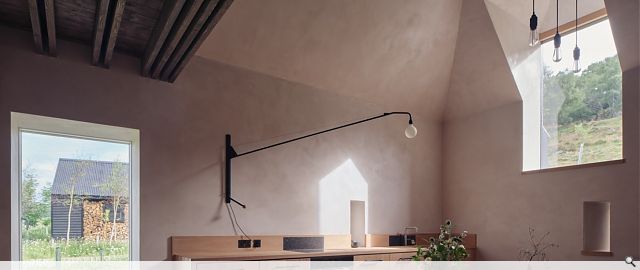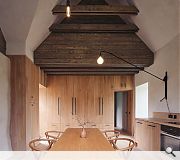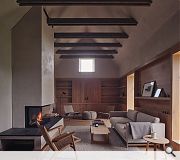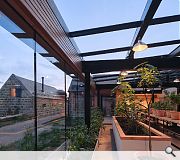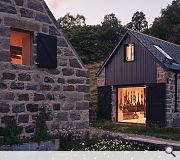Ardoch House
Moxon Architects has transformed a collection of 19th-century agricultural buildings, creating a new guesthouse, glasshouse and artist’s studio for a private artist/architect client on a hillside farm settlement in the Cairngorms National Park, Aberdeenshire with impressive wide-ranging views over the River Dee and Lochnagar.
Following a decade-long undertaking, the newly converted buildings have been restored and repurposed in keeping with the restoration of the owners’ main farmhouse residence. Using a combination of traditional and contemporary construction methods each of the buildings have been transformed for the 21st-century and have been developed to meet modern standards of energy efficiency, while remaining sympathetic to the original craftsmanship and the surrounding Highland vernacular of the North East of Scotland.
The largest building on the site has been repurposed to give additional study and living space to the client’s main residence, while providing self-contained guesthouse accommodation for visiting friends and family. Beyond a principal entrance and kitchen space, a living room and study occupy one double-height wing of the solid ‘L’ plan granite and slate building, while a ground-level bathroom suite and upper-level loft bedroom complete the adjacent wing. The architects have carefully rebuilt and restored the partially collapsed walls and roof of the original 19th-century cattle shed, inserting frameless glass within the original apertures to preserve the building’s vernacular detail and form.
Using the pre-existing volumes as a template for the new living spaces, the interior has been fully insulated and lined with clay plaster to give a seamless, spacious feel, while oak joinery conceals modern appliances and fittings preserve a minimalist rural aesthetic. The bathroom features ceramic clad walls and dark black-grey Caithness slabs. A new roof emulates the original construction techniques, introducing a newly rationalized pyramidal geometry at the hip, while the hayloft entrance and ventilation slits for the former cattle byre define the guesthouse entrance.
A formerly collapsed farm store and sheepfold at the rear of the site has been reinvented as a glasshouse, partially embedded into the bedrock of the hillside by a pre-existing retaining wall. The original granite structure now serves as the backdrop to vines and lemon trees, and as a thermal store, soaking up heat from the new southwest facing glass wall and roof that complete the enclosure. Steel portals support the roof, with large section Douglas fir fins define a sheltered external space at one end and a secluded exercise room at the other.
The glasshouse is the product of collaboration between the artist/architect owners, joiners Jacek and Waldi Zapała and steelwork fabricator Craig Monteith. Iteratively designed bespoke lighting is clamped to the glasshouse’s steel beams. Water for irrigation of plants is collected from the roof and stored in an internal tank which overflows to an external water butt carved from a windblown larch tree, and internal condensation is collected by a copper gutter and distributed into a bay tree planter. Ventilation is adjusted by large opening hatches along the top back edge of the building while supplemental heating can be provided by a wood burning workshop stove. At the northern end of the glasshouse, a two-storey farmstead has been repurposed as a private studio for artist and designer Naomi Mcintosh.
Formerly used to winter sheep, the granite steading has been sensitively converted, to provide a compact workshop, kitchen, wet room, and storage, using robust materials to retain its agricultural character. The studio incorporates a steel block insertion, finished in a protective phosphate coating and beeswax, giving the space a sense of durability and depth. The former square entrance to the steading has been glazed with a single sheet of glass, and the bespoke floor, ceiling and stair tread are made from a wide-boarded Maritime pine, offering seamless contemporary lines. The addition of the wood-burning stove serves as both a nod to the tradition of its rural surroundings, as well as providing the primary source of heat during extreme Highland winters.
Back to Housing
- Buildings Archive 2024
- Buildings Archive 2023
- Buildings Archive 2022
- Buildings Archive 2021
- Buildings Archive 2020
- Buildings Archive 2019
- Buildings Archive 2018
- Buildings Archive 2017
- Buildings Archive 2016
- Buildings Archive 2015
- Buildings Archive 2014
- Buildings Archive 2013
- Buildings Archive 2012
- Buildings Archive 2011
- Buildings Archive 2010
- Buildings Archive 2009
- Buildings Archive 2008
- Buildings Archive 2007
- Buildings Archive 2006


